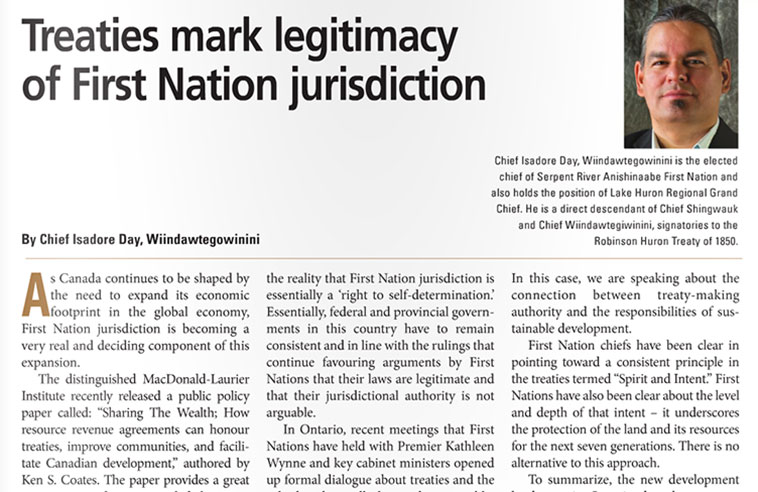
TORONTO March 2, 2015 – Anishinabek Nation Lake Huron Regional Chief Isadore Day says that First Nation issues and interests will be more defined this year at the 15th Annual Prospectors and Developers Association (PDAC) meeting being held this week in Toronto.
“Major issues affecting Ontario’s resource sector will be discussed,” says Chief Day whose community of Serpent River is signatory of the Robinson Huron Treaty of 1850. “Developers and investors seek to establish formal business relationships with respect to the mining industry. The Ring of Fire is one of many examples.”
Despite the buzz around business development and the opportunities to generate wealth and employment, many First Nation leaders are suggesting that the mining industry must recognize the critical aspects of “treaties” and “sustainability”.
Some First Nations chiefs are going as far as to say that the Ontario government must clearly draw the link between First Nation jurisdiction and provincial policy; and that this link must be the starting point of consultation to any mining development in regions where treaties were entered into with the crown.
“Our First Nations and the treaties that our ancestors entered into have been left out of formal decision and policy-making for far too long,” says Chief Day. “This Ontario government can no longer have silo-style dialogue with us on the matter of treaty implementation – and leave the matter of treaty undefined in negotiations. This dialogue must be the basis for how mining evolves in this province – or it can’t go ahead at all, it’s that simple.”
Of concern to many First Nation leaders going forward in an evolving 21st Century mining era, are issues around the environment, social impacts and economic benefits.
“All of these important areas of focus are from the perspective of First Nation jurisdiction. Essentially these are all the formal responsibilities that First Nations leaders are legally and morally entrusted to protect,” says Day.
“Jurisprudence related to Aboriginal rights in Canada continues to evolve over time, providing clarity while raising additional questions and ultimately contributing to shaping and reshaping the landscape of the mineral sector. Meanwhile, some elements, such as accommodation and the delegation of procedural aspects of consultation, remain ambiguous. This session will examine recent Supreme Court of Canada decisions and the key challenges and opportunities that arise for mineral companies and Aboriginal communities in relation to resource development. A panel discussion will also be held to discuss different perspectives on the duty to accommodate.” PDAC Program 2015
Chief Isadore Day and many leaders are paying close attention to Ontario’s mining sector these days because of specific commitments from the Ontario Premier and Cabinet, formally indicating to the Chiefs in Ontario that they are prepared to get serious about treaty implementation and First Nation jurisdiction in the province.
With developments in the Ring of Fire and in many other treaty jurisdictions throughout the province, “sustainability” will be an important policy discussion for many years to come, where First Nations and the Ontario government come to specific terms with matters around “treaty” and “First Nation jurisdiction”.
“To be clear, Ontario can only move forward on mining in this province if it prepared to define treaty regions formally in the consultation process; advance dialogue with treaty leaders and create joint policy around treaty-region specific mining developments,” says Day. “Failure to take these measures, will surely contribute to ongoing challenges in Ontario’s mining sector.”
Day has contributed to the PDAC Edition of the Canadian Mining Journal February/March 2015; in an article called “Treaties Mark Legitimacy of First Nation Jurisdiction” where he highlights how decisions must be made around the mining sector in Ontario, reflective of treaties and sustainable development. http://www.canadianminingjournal.com/issues/de.aspx?&er=NA
First Nation leaders in Ontario have long echoed the call for treaties to be formally recognized in all natural resource development – “Now,” says Day. “Ontario must demonstrate in good faith that it is willing to put action and integrity to the recognition of ‘treaty rights’ that have been clearly inserted into the Ontario Mining Act.”
The Anishinabek Nation established the Union of Ontario Indians as its secretariat in 1949. The UOI is a political advocate for 39 member communities across Ontario, representing approximately 55,000 people. The Union of Ontario Indians is the oldest political organization in Ontario and can trace its roots back to the Confederacy of Three Fires, which existed long before European contact.
For more information contact:
Marci Becking, Communications Officer
Phone : 1-877-702-5200 ext. 2290
Email : becmar@anishinabek.ca
www.anishinabek.ca
www.anishinabeknews.ca








